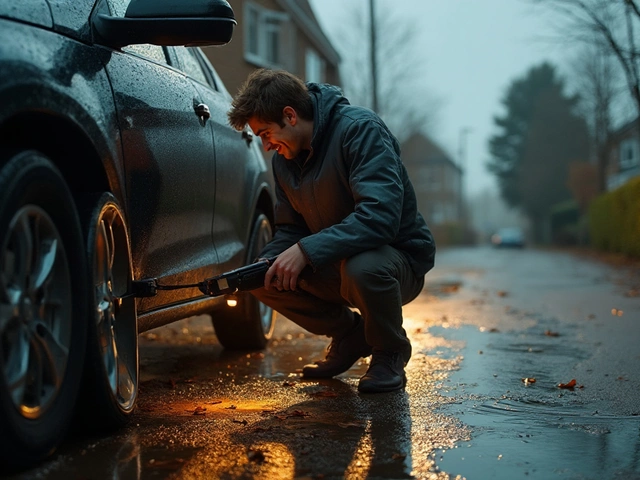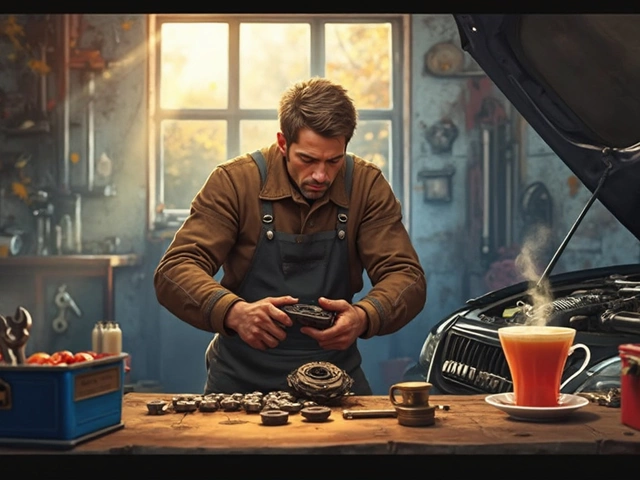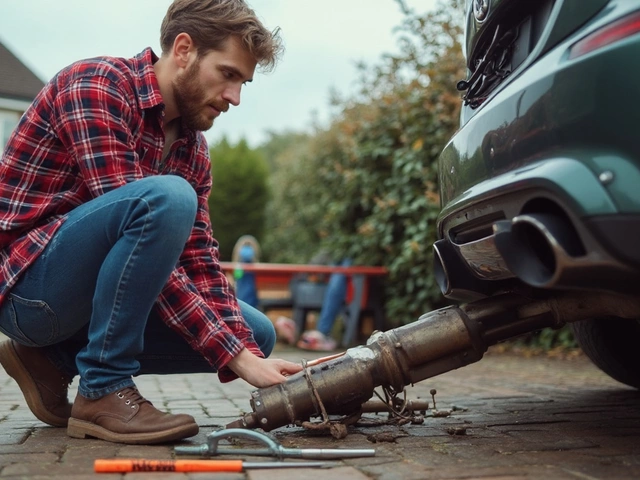A fuel pump gone bad won’t just leave you stuck—it can ruin your day fast. Not sure if it’s your pump acting up? You’re not alone. Most folks notice their car having trouble starting, or maybe it sputters and dies when you hit the gas. These are classic hints pointing straight at your fuel pump.
Before you splash cash on any new parts, let’s sort out what’s really going on. You don’t need to be a mechanic to test your fuel pump. Even if you’ve never touched a wrench, there are tricks and checks you can try at home, using things you already have—or just your own two ears. Stick with me and you’ll get the basics down.
- Spotting the Signs of a Bad Fuel Pump
- Quick Tests You Can Do at Home
- Testing with Tools: Pressure Gauges and Multimeters
- When to Call a Mechanic
Spotting the Signs of a Bad Fuel Pump
Wondering if your ride's acting up because of the fuel pump? There are some classic red flags you’ll notice before it gives up completely. Ignoring these signs can leave you stranded—seriously not fun if you’ve got places to be.
- Hesitation or Sputtering: Your car starts fine, but then it stumbles or feels like it’s running out of power, especially when you speed up or climb a hill.
- Hard Starting: Sometimes your engine turns over for ages before it actually starts. Sometimes, it just won’t start at all.
- Random Stalling: Driving seems normal, then suddenly the engine just quits as if it’s out of gas—even when your tank is half full.
- Whining Noise from the Tank: It shouldn’t sound like a beehive under your back seat. A constant high-pitched whine where the pump sits (usually back by the gas tank) is a big hint the pump’s in trouble.
- Decreased Fuel Efficiency: If you’re hitting the gas station more often with the same habits, the pump could be making the engine work harder to get enough fuel.
These symptoms are really common when a pump is on its last legs, but they can point to other issues too—like a clogged fuel filter or wiring trouble. That’s why it helps to check which symptoms add up before you blame the pump.
| Sign | How Often It Occurs When Pump Fails |
|---|---|
| Engine hesitation/sputtering | 70% |
| Hard starting | 60% |
| Random stalling | 55% |
| Whining noise | 50% |
| Increased fuel stops | 40% |
Tip: Cars built after 1996 have computers that sometimes throw an error code if the fuel pump isn’t keeping up. Check for codes P0230 or P0231 with a simple scan tool—no fancy equipment needed.
Quick Tests You Can Do at Home
You don’t need high-end gear to figure out if your fuel pump is the troublemaker. A few simple checks can already point you in the right direction. Here’s what you can do in your own driveway, even if you’re not into car repair.
- Listen for the Whirring Sound
If your car still starts—before turning the key all the way, turn it to the “on” position. You should hear a soft whirring or humming noise from the fuel tank area, usually lasting a couple of seconds. No sound at all? Your pump might not be turning on. - Crank and Check
Try starting your car. If it cranks but refuses to start or only runs for a second and dies, your pump could be the culprit. - Fuel Pressure Release
Find the Schrader valve (looks like a big tire valve) on your fuel rail under the hood. With the engine off, press it gently with a rag for safety. If fuel barely dribbles out or nothing comes out, there’s likely no pressure being delivered—another sign the pump’s gone bad. - Tapping the Fuel Tank
This might sound goofy, but it’s a classic test. If the pump is sticking, sometimes tapping the fuel tank gently with a rubber mallet while someone cranks the engine gets the car running for a moment. If this trick works, don’t celebrate—your pump’s definitely on its last legs.
For a quick reference, here’s a table showing what symptoms match up with a failing fuel pump:
| Test | What You Might See or Hear | What It Means |
|---|---|---|
| Key-on humming sound | Soft whir/hum for 2 seconds | Fuel pump likely working |
| No humming sound | Silence from the tank area | Pump may be dead |
| Crank but no start | Engine turns but won’t start | Pump probably failed |
| Tapping tank test | Engine starts after tapping | Sticking pump – replacement needed |
Most cars built after 1996 send power to the pump for just two seconds with key-on. If you don’t hear that quick whirr, start by checking your fuses and relays—sometimes it’s an easy fix. But if all signs point to the pump, it’s time to plan your next move.

Testing with Tools: Pressure Gauges and Multimeters
If you want to really know if your fuel pump is the root of your troubles, break out the tools. Mechanics love using pressure gauges and multimeters because they give you numbers, not guesses. No need for a fancy garage—most auto parts stores will rent you the basics.
Start with a fuel pressure test: Every car has a specific fuel pressure range (usually in PSI—pounds per square inch). Here’s what you do:
- Find your vehicle's fuel test port—usually on the fuel rail under the hood. Your manual can help here.
- Attach the fuel pressure gauge snugly to the port. Double-check for leaks.
- Turn the key to "On" (don’t start the engine). Watch the gauge; it should jump up right away.
- Compare your reading to the number in your manual. Too low or zero? Your pump might be toast.
Most modern cars should see somewhere between 40 and 60 PSI at the rail. Here’s a quick comparison table with some sample numbers, so you get the idea:
| Car Model | Expected PSI |
|---|---|
| Honda Civic (2005) | 47-54 |
| Ford F-150 (2010) | 55-62 |
| Toyota Corolla (2012) | 44-50 |
| Chevy Silverado (2015) | 58-65 |
If your numbers are off, you know something’s up with your fuel system. But don’t forget—sometimes fuel filters or pressure regulators cause problems, not just the pump itself.
Next, break out the multimeter. Your pump’s got to have electricity to work. Here’s how you check:
- Disconnect the fuel pump’s electrical connector. (Usually under the car, near the fuel tank. Wear gloves and don’t smoke!)
- Set your multimeter to DC volts. Plug the black lead to ground, the red to the connector’s power wire.
- Key "On" again. You want to see battery voltage—something around 12 volts.
- If there’s no voltage, your problem’s probably wiring or a relay, not the pump itself.
Here’s a tip: If your gauge shows the right pressure, but the car stutters, your pump might still be weak when running. Try the test with the engine idling and then revving up. Dips in pressure under load usually mean the pump is failing.
Using these simple tools takes the guesswork out and lets you fix problems fast. No more swapping out random parts and hoping for the best.
When to Call a Mechanic
Sometimes, no matter how many checks you do at home, your car just keeps acting up. That's your cue to get a pro involved. If you’ve gone through basic fuel pump checks—like listening for pump noises, using a pressure gauge, or checking fuses—and things still don’t add up, don’t keep guessing. Today's cars are packed with sensors and computers, so a simple mistake can turn into a costly headache.
Let’s get specific. You should reach out to a mechanic if:
- The engine cranks but never starts, even with fresh fuel and a strong battery.
- You notice fuel leaks or smell raw gasoline near the pump or lines. That’s a safety risk and needs quick action.
- Your fuel gauge is all over the place, or other dashboard warning lights come on—these can point to electronic issues that need special tools.
- Your tests with a fuel pressure gauge show a reading much lower than your car’s specs, or no pressure at all.
- You find electrical problems, such as blown fuses that keep coming back, or wires that look burnt or corroded.
Here's a quick look at what jumps out in fuel pump problems and when expert help makes sense:
| Issue | DIY Friendly? | Should See Mechanic? |
|---|---|---|
| Failed fuse | Yes | No, unless it keeps failing |
| No fuel pressure | Maybe (if tools available) | Yes |
| Fuel leaks | No | Yes (urgent) |
| Wiring issues | Maybe | Yes |
| Fuel pump replacement | No | Yes |
Fact: Around 1 in 5 fuel pump replacements are misdiagnosed, according to industry repair data. That’s because problems like clogged filters, bad relays, or even security system errors can look a lot like a bad pump. So if you’re not sure, getting a professional diagnosis can save you money and stress.
And remember, a botched fuel pump job can leave a car completely dead or even create a fire risk. If you’re feeling out of your depth, don’t risk it—pick up the phone and book a shop visit.




